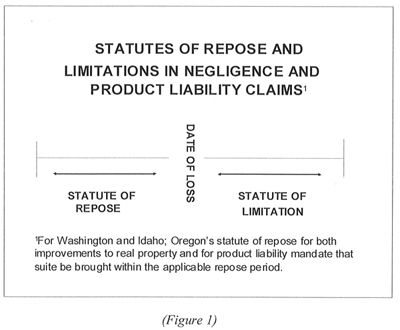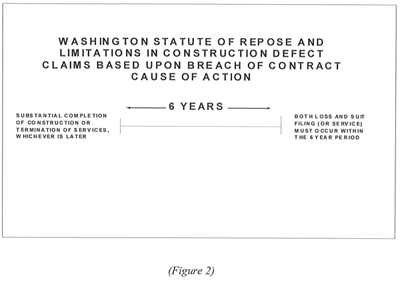Updated Statutes of Repose vs. Statutes of Limitation
March 24, 2011
By Thomas A. Wolfe, JD, LLM, The Wolfe Firm
Statutes of Repose for Improvements to Real Property
Normally, a statute of repose is an expression by the state legislature as to how far back one may look from the date the cause of action arises to have a valid cause of action. To put it into the real property context, the statute will dictate how far back in time an entity that is involved with construction or design of improvements to real property will be liable for a construction defect causing a property loss.
In contrast, a statute of limitations is the period by which suit must be filed from the date the cause of action arises. Moreover, the statute of repose is backward-looking, while the statute of limitations is forward-looking (Figure 1).
There are several exceptions to these caveats. In Oregon, for example, the statute of repose for improvements to real property also requires that suit be filed within the ten year repose period.
Additionally, the date the cause of action accrues will depend upon both the state and the type of claim involved. As an example, in Washington, the cause of action for breach of a construction contract arises at the date of breach rather than the date of discovery (unless the defect is latent), but the absolute limitations period on such a claim coincides with the statute of repose (even in the case of a latent construction defect (Figure 2). See 1000 Virginia, Ltd. Partnership v. Vertecs Corp., 153 Wn.2d 566, 146 P.3d 423 (2006) and RCW 4.24.126(g). However, a cause of action based on negligence will arise on the date of discovery (or the date that the insured should have discovered the problem). This latter date is usually the date of loss (Figure 1).
Real property statutes of repose for the Pacific Northwest may be summarized as follows:
- Washington (RCW4.16.310): Six years from substantial completion of construction.
- Oregon (ORS §12.136): Ten years from substantial completion of construction (suit must also be filed by that time).
- Idaho (IC §5-241): Six years from final completion of construction.
It should also be noted that the term “substantial completion of construction” and “final completion of construction” are terms of art and thus, if the dates are close, the progress of the construction project needs to be examined carefully.


Product Statutes of Limitation and Repose
In the Pacific Northwest states, product liability has both its own statute of repose and statute of limitations. Often, these statutes of limitation are shorter than the statute of limitations that would be applicable to a property claim that was based on a cause of action other than product liability.
These limitation periods may be summarized as follows:
- Washington Product Liability Act (RCW Chapter 7.72):
a. Product Statute of Repose – there is a rebuttable presumption that the product is beyond its useful safe life if it is more than 12 years old.
b. Statute of Limitations: Three years from the date of discovery (or when should have been discovered). - Oregon (ORS §30.905):
a. Product Statute of Repose – A product liability civil action must be commenced before the latter of:
i) Ten years after the date on which the product was first purchased for use or consumption; or
ii) The expiration of any statute of repose for an equivalent civil action in the state in which the product was manufactured, or, if the product was manufactured in a foreign country, the expiration of any statute of repose for an equivalent civil action in the state into which the product was imported. ORS §30.905(2).
b. Statute of Limitations – A product liability action must be commenced not later than two years from the date of discovery (or when should have been discovered). ORS §30.905(l) - Idaho (IC §6-1300, et seq.):
a. Product Statute of Repose – there is a rebuttable presumption that the product is beyond its useful safe life if it is more than 10 years old.
b. Statute of Limitations: Property damage claim must be brought within two years from the time of the occurrence, act or omISSIOn (see IC Sections 6.1403 and 5-219).
In both Washington and Idaho, the statutes of repose contain a rebuttable presumption that the product is beyond its useful safe life if it is older than 12 years in Washington and 10 years in Idaho. This presumption may be overcome by a preponderance of the evidence.
For example, consider the product failure of a major piece of equipment used in manufacturing which is more than 12 years old. Such a machine is very expensive and expected to be operated safely for at least 30 years. Under these circumstances, it is wholly reasonable to assume that the useful safe life of such a machine is well in excess of the presumption period under the statute. This can be contrasted with the failure of a small household appliance, such as a coffee maker. In this latter case, the presumption respecting useful safe life may be much more difficult, if not impossible, to overcome.
If you have questions please contact your Account Executive or Tom Wolfe at 206.682.4488 or tom.wolfe@thewolfefirm.com.
About the Author: Thomas A. Wolfe is the principal and founder of The Wolfe Firm, a Seattle based law firm well known to property insurance claims management throughout the United States and Canada. The firm engages primarily in the investigation, pursuit, and litigation of large loss property subrogation cases in the Pacific Northwest. These cases involve water, fire, explosion, system failure, product liability, construction defects, negligence, marine and related areas. Mr. Wolfe has personally pursued countless commercial and personal lines subrogation cases, and he has obtained more than several recoveries in excess of a million dollars in various complex product liability and negligence cases. He has also been directly involved in several “mass tort” cases in the Pacific Northwest where fire or explosion has caused death and other personal injury and widespread property damage. He has engaged, worked with and observed the testimony of countless experts in both the Northwest and the rest of the country in a myriad of disciplines. He has given seminars in fire and property subrogation to a number of carrier clients and claim associations, and he authors the semi-annual publication The Property Subrogation Report. Tom can be reached at 206.682.4488 or tom.wolfe@thewolfefirm.com.
NOTE: Each case turns on its own facts and the applicable law at the time. The foregoing should not be relied upon for legal analysis.
The views and opinions expressed within are those of the author(s) and do not necessarily reflect the official policy or position of Parker, Smith & Feek. While every effort has been taken in compiling this information to ensure that its contents are totally accurate, neither the publisher nor the author can accept liability for any inaccuracies or changed circumstances of any information herein or for the consequences of any reliance placed upon it.

